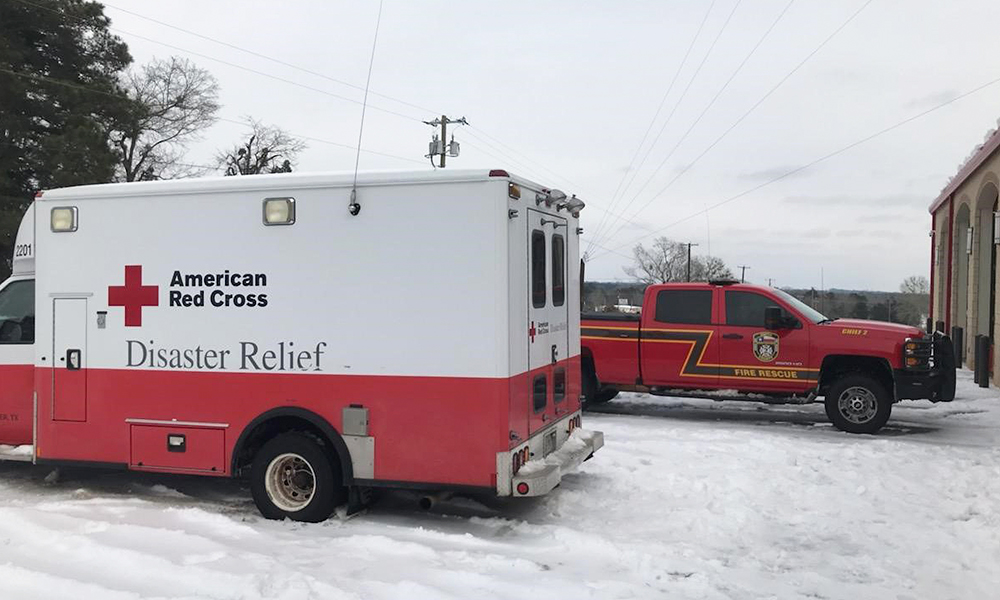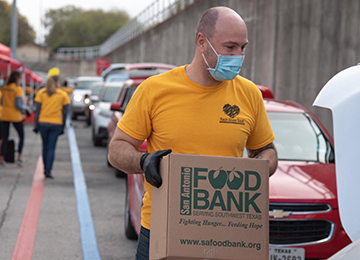Winter Storm Uri 2021 Texans Respond During and After the Storm
Texans have a history of showing up for their neighbors —and the winter storm of February 2021 was no exception. For the millions who endured power outages and no running water amid freezing temperatures, the need for essentials became a dire issue. Many turned to family and friends for help. Others sought assistance and relief from local community organizations and businesses. Those included the American Red Cross, food banks and even a South Texas-based grocery store chain that worked together, and in some cases, partnered to provide services.

Photo courtesy of the East Texas American Red Cross
Community Partnerships
“The greatest needs for residents in North Texas during and after the February winter storm were warming stations, information, food, water and health and mental health support,” says Krystal Smith, regional communications director with the American Red Cross of the North Texas Region (North Texas ARC). The region serves about 9 million people in 121 counties through the work of six local chapters.
Smith says each service was provided through community efforts that involved more than 300 trained Red Cross staff working alongside community and government partners. Prior to the storm, she says the Red Cross already was working closely with local jurisdictions across the state to offer support as they opened warming centers for those seeking refuge from severe weather conditions.
“This included proactively providing more than 500 cots and 1,000 blankets in the North Texas area alone before the storm hit,” Smith says.
Exhibit 1: BLOOD DRIVE DONATIONS IN TEXAS, FEBRUARY 2020, 2021*
*Figures are approximate.
Source: American Red Cross of North Texas
As the storm progressed across the state, these partnerships continued providing more than 140,000 meals and snacks and distributing more than 12,000 supplies, such as comfort kits containing hygiene essentials. In addition, the partnerships provided more than 1,600 professionals to assist with physical, emotional and spiritual care needs.
Compounding efforts to provide basic food and shelter, says Smith, was the demand for blood donations (Exhibit 1) — all of which created a sense of greater urgency as the ice storm continued unabated. Because of inclement weather, North Texas ARC cancelled 46 blood drives. Across the state, those cancellations resulted in a big loss of donated blood.
Another issue North Texas ARC faced was an increase in calls requesting assistance for home fires. “The number of home and apartment fires significantly increased as people attempted to warm their homes,” she says. “In February 2021, the North Texas Red Cross responded to 285 fires and assisted over 1,400 people — more than double the previous year.”
Exhibit 2: RESPONSES TO HOUSE FIRES BY NORTH TEXAS ARC
Source: American Red Cross of North Texas
Exhibit 2 shows the year-over-year increase in response to home fires by North Texas ARC. On Feb. 19, the National Fire Protection Association reported that the winter storm and resulting power outages were contributing to home fires and carbon monoxide poisoning as residents used unsafe methods to warm homes, keep lights on and prevent pipes from bursting.
The Search for Food
Farther east, the circumstances were just as dire. Unsafe road conditions and flooding in the offices of the East Texas Food Bank in Tyler posed a big problem.
“Since we cover 26 East Texas counties, we had to completely shut down our operations for a week because staff could not safely travel to work and the road conditions were hazardous for our drivers,” says food bank CEO Dennis Cullinane.
But even with the organization’s warehouse shut down, he says that its leadership was able to immediately assist the community by distributing emergency supplies.
“Though we do not have a specific count on how many people needed help, our food distribution hit record levels immediately after the storm and persisted until our partner agencies were able to be restocked,” Cullinane says.
Meanwhile, at the San Antonio Food Bank in South Texas, a similar scenario was underway.
“We generally are responding to a natural disaster in a different region, but this one was right on top of us,” says Eric Cooper, president and CEO of the San Antonio Food Bank. “It kept us off the roads and without distribution nodes for emergency food and meals.”
It all worked out with a little help, Cooper says. “We had to lean on the local police department to transport food and meals to those [who were] stranded.”
Cooper added that many in need were not the food bank’s usual clientele. “We also were providing meals for more well-off households who had no power and nowhere to go but hotels. And the hotels had no ability to get the food or water, so we handled that as well.”
Still hundreds of others lined up at the San Antonio Food Bank’s headquarters seeking the essentials that they couldn’t find at area grocery stores.

Photo courtesy of San Antonio Food Bank
On Feb. 19, several days into the storm, Craig Boyan, H-E-B president, posted a video on the grocer’s Facebook page to address some of the issues the company was facing.
“Like many across the state, our stores, our manufacturing plants, our warehouses, our partners and drivers have been seriously affected by this storm,” he says. “But know we are doing all we can to select and load trucks, to ship products safely to stores and take good care of you.”
Among business responses, the privately held supermarket chain, based out of San Antonio, made national headlines for its response. Some even referred to the company as the model of emergency preparedness, and Texans couldn’t have been more appreciative as they took to social media to let everyone know.
The COVID Effect
Then there was COVID. On the upside, Cullinane says the East Texas Food Bank’s pivot to working remotely during the pandemic helped.
“Though our facility was inaccessible and closed, many staff members had been given laptops and were able to work from home without losing much effectiveness,” he says. “I was able to continue our strategic planning and communicate with our local emergency response officials to redirect some truckloads of food from the food bank to warming sites.”
For the San Antonio Food Bank, the downside was the disruption of its distribution chain.
“We had more than 500 food pantry partners helping in the distribution of food across 16 counties,” says Cooper. “COVID closed more than 90 percent of those pantries. The food bank was left without a normal distribution channel for 40 percent of its food.”
He adds that for many months there had been no food to pick up at grocery stores or restaurants, which had been normal sources before the pandemic.
“Additionally, food manufacturers were struggling to fulfill orders and did not have overages, again leaving less for food banks across the U.S.,” Cooper says. “Only recently has this gotten better.”
Impact on Wildlife
Humans weren’t the only ones hit hard by this historic storm. The Texas Parks and Wildlife Department (TPWD), in an online Texas Master Naturalist seminar in April, reported that hundreds of thousands of animals perished as the result of the severity of the storm. They included birds, bats, exotic deer, sea turtles and fish.
Dakus Geeslin, with the TPWD Coastal Fisheries Science and Policy Branch, says the fish kill alone was the largest freeze-related event since the 1980s.
“The geographic extent was the entire coast,” he says. “We saw freezing temperatures all the way from Port Arthur near the Louisiana border … to Brownsville near the Rio Grande.”
TPWD estimates approximately 3.8 million fish succumbed to the freeze event. In that same online seminar, Tony Reisinger, Cameron County Marine Extension Agent, said about 13,000 cold-stunned sea turtles were reported in Texas. According to fishery experts at the National Oceanic and Atmospheric Administration (NOAA), cold-stunning is a condition in which sea turtles become very weak and inactive from exposure to cold temperatures, usually when water temperatures drop below 50 degrees Fahrenheit.
“We had many working on retrieving these turtles that were cold-stunned — Texas Parks and Wildlife, fisheries biologists, law enforcement agents and many volunteers,” Reisinger says. “We even had children helping transport sea turtles.”
Preparing for Another Storm
Months after the winter storm, many Texans continue to deal with the damage it left behind. And many caught in Winter Storm Uri’s harsh conditions have been thinking about what they can do to prepare for another storm. Smith of North Texas ARC is thinking about that, too. “The Red Cross plans to continue working closely with government and community partners to find the best ways to efficiently provide services to those who need it most.”
Although unforeseen circumstances can disrupt even the best-made emergency plans, community organizations are rededicating themselves to prepare for the next big event. The San Antonio Food Bank is looking at scenario planning with local emergency management offices. The East Texas Food Bank will be installing an emergency generator for backup power. And the Red Cross is focused on educating the public on how to prepare for weather emergencies.
“Most importantly, we want to encourage everyone to build an emergency kit, make an emergency plan and stay informed,” Smith says. “Ideally, each person’s emergency kit should be equipped with supplies for three days, if evacuating, and two weeks, if staying at home.”
Detailed emergency preparedness information is available on the American Red Cross’ website and is organized by the types of emergencies and natural disasters that potentially could affect each region. FN
Each year, the state of Texas offers a sales tax holiday for emergency preparation supplies that includes fuel containers, flashlights and certain portable generators. A complete list of items that may be purchased tax-free is available on our website. The next sales tax holiday for emergency supplies is April 23-25, 2022.

